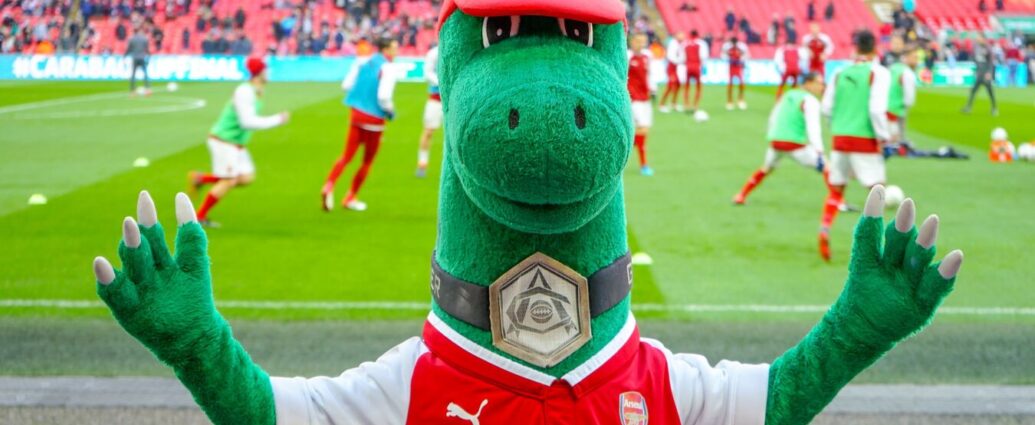Anna Boyne
Iconic marketing mascots like the Andrex Puppy and Ronald McDonald have been around for many decades. Part of this clan are sports mascots, who might be the face of sporting teams, but their psychology often gets overlooked.
A lucky charm
Mascot is derived from the French word “mascotte”, meaning a “lucky charm.” The earliest examples of sports mascots were live animals, with whom teams aimed to boost the morale of players and fans. They quickly became connected with the psychology of victory, especially when mascots embodied sporting virtues like determination and fearlessness.
Withstanding the test of time
Unlike all the best athletes, mascots never have to retire. Throughout the victories and losses, the league promotions and demotions, mascots stay the same. They provide a sense of stability and continuity.
Believed to be the first live sports mascot, Handsome Dan was a bulldog that belonged to a member of the Yale class of 1892, and remains the mascot today. A family of Yale supporters may have been backing the bulldogs for generations, adding to a sense of heritage that goes beyond just one season.
another year, another awkwards (but Handsome) yearbook photo. pic.twitter.com/uztoODDfWQ
— Handsome Dan XIX (@HandsomeDanYale) August 15, 2023
A sense of belonging
According to LiveLike, “Sports fandom is about more than just watching games and cheering for your favourite teams. For many, it is a deep-seated psychological need to connect with the athletes and other fans, to feel a sense of belonging and excitement.”
“People derive much of their self-worth from belonging to social groups”
Social identity theory argues that people derive much of their self-worth from belonging to social groups. Fans supporting a team share the same interests and values, forming a large communities.
A recent study found that mascots play a key role in establishing this psychological closeness between sports teams and their fans. This humanisation of animals, objects, and characters can be defined as anthropomorphism.
“The effects of anthropomorphism were most prominent amongst fans experiencing loneliness”
The study also found that the effects of anthropomorphism were most prominent among fans experiencing loneliness. Those seeking a sense of belonging often found it in their support for sports teams, with mascots bridging the gap. Sports teams simultaneously benefitted from boosted ticket and merchandise sales.
Olympic mascots
Since the 1968 Grenoble Winter Olympic Games, mascots have played a central role in the quadrennial competition. They have been designed to embody both sporting values and inspiration from the host country’s history and culture.
“The mascots have often been national symbols of the host country.”
The mascots have often been national symbols of the host country. For example, the Canadian beaver of Montreal in 1976, the US eagle of LA in 1984, and the Soviet Union’s brown bear of Moscow in 1980.
The Seoul 1988 mascot was Hodori, a tiger cub – a character common in Korean legends portraying the hospitable traditions of the Korean people.
Paris 2024 Mascots
The Phryges are the upcoming Paris 2024 mascots. These two characters are shaped like the Phrygian cap. A symbol of revolutions, the French Republic, and freedom. The French national icon Marianne is often depicted wearing it, for example in Delacroix’s iconic painting “Liberty Leading the People.”
On vous présente la Phryge Olympique et la Phryge Paralympique !
Les mascottes de #Paris2024 ✨
Sportives, fêtardes… et françaises 🇫🇷Here are the Olympic Phryge and the Paralympic Phryge!
The #Paris2024 mascots ✨
They are sporty, love to party… and are so French 🇫🇷 pic.twitter.com/plupKzQqNs— Paris 2024 (@Paris2024) November 14, 2022
“Our mascots want to play a role in the lives of French people and help bring more sport into our everyday life,” said the Paris 2024 Olympic Committee. “And what could be better than little Phrygian caps to lead this revolution through Sport with Paris 2024?”
Olympic mascots allow host countries the opportunity to shape the games around their traditions and values. They aim to drive positive change, make the games beneficial for the entire population, and instil a sense of national pride.
Perpetuating racist stereotypes
That said, the psychological effect of mascots is not always a positive one. The US has a long history of appropriating Native American iconography, extending to mascots founded on problematic stereotypes of fierceness and tribalism. These characterisations have historically been used to legitimise the killing of Native American people and restrict them to reservations.
“The team still continues to sell merchandise bearing the smiling, red-faced caricature.
The Committee of 500 Years of Dignity and Resistance campaigned for over 30 years to have the mascot of “Chief Wahoo” and the name “Indians” removed from Cleveland’s professional baseball team. They removed “Chief Wahoo” from uniforms in 2018, and replaced it with the “Cleveland Guardians”. However, the team still continues to sell merchandise bearing the smiling, red-faced caricature.
“These mascots reinforce racist stereotypes.”
A study into the psychological impact of these Native American mascots identified their harmful effect on social identity development and self-esteem, especially in a school environment. These mascots reinforce racist stereotypes and hinder Native Americans’ ability to accurately and respectfully represent their culture, spirituality, and traditions. This creates a hostile environment for members of all communities.
Sporting spirit
Mascots are an embodiment of sporting spirit and community identity. Win or lose, they must continuously evolve to insure inclusion is always championed. Without a mascot, not only would teams lose a community figure but an essential link for moving their team between generations and into the future.
READ NEXT:
-
WORLD ATHLETICS CHAMPIONSHIPS 2023: THE BEST OF BRITAIN
-
THE ACL INJURY ‘EPIDEMIC’ IN WOMEN’S FOOTBALL
-
FIFA WOMEN’S WORLD CUP 2023: THE LIONESSES’ BEST MOMENTS
Featured image courtesy of Luke Wang on Unsplash. No changes were made to this image. Image license found here.

